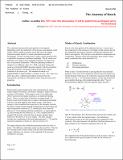The Anatomy of Knock
Author(s)
McKenzie, Jacob Elijah; Cheng, Wai K
Download2016-01-0704 Anatomy of Knock.pdf (598.5Kb)
OPEN_ACCESS_POLICY
Open Access Policy
Creative Commons Attribution-Noncommercial-Share Alike
Terms of use
Metadata
Show full item recordAbstract
The combustion process after auto-ignition is investigated. Depending on the non-uniformity of the end gas, auto-ignition could initiate a flame, produce pressure waves that excite the engine structure (acoustic knock), or result in detonation (normal or developing). For the “acoustic knock” mode, a knock intensity (KI) is defined as the pressure oscillation amplitude. The KI values over different cycles under a fixed operating condition are observed to have a log-normal distribution. When the operating condition is changed (over different values of λ, EGR, and spark timing), the mean (μ) of log (KI/GIMEP) decreases linearly with the correlation-based ignition delay calculated using the knock-point end gas condition of the mean cycle. The standard deviation σ of log(KI/GIMEP) is approximately a constant, at 0.63. The values of μ and σ thus allow a statistical description of knock from the deterministic calculation of the ignition delay using the mean cycle properties.
Date issued
2016-04Department
Massachusetts Institute of Technology. Department of Mechanical EngineeringJournal
SAE Technical Papers
Publisher
SAE International
Citation
McKenzie, Jacob, and Wai K. Cheng. “The Anatomy of Knock.” SAE Technical Paper, SAE International, 2016.
Version: Author's final manuscript
ISSN
0148-7191